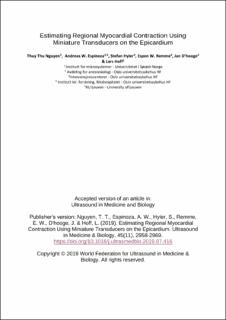| dc.contributor.author | Nguyen, Thu Thuy | |
| dc.contributor.author | Espinoza, Andreas Westenvik | |
| dc.contributor.author | Hyler, Stefan | |
| dc.contributor.author | Remme, Espen W. | |
| dc.contributor.author | D'Hooge, Jan | |
| dc.contributor.author | Hoff, Lars | |
| dc.date.accessioned | 2020-11-12T14:11:54Z | |
| dc.date.available | 2020-11-12T14:11:54Z | |
| dc.date.created | 2019-10-21T11:32:00Z | |
| dc.date.issued | 2019 | |
| dc.identifier.citation | Nguyen, T. T., Espinoza, A. W., Hyler, S., Remme, E. W., D'hooge, J. & Hoff, L. (2019). Estimating Regional Myocardial Contraction Using Miniature Transducers on the Epicardium. Ultrasound in Medicine & Biology, 45(11), 2958-2969. | en_US |
| dc.identifier.issn | 0301-5629 | |
| dc.identifier.uri | https://hdl.handle.net/11250/2687659 | |
| dc.description.abstract | This paper describes an ultrasound system to monitor cardiac motion using miniature transducers attached directly to the epicardial surface. Our aim was to develop both a research tool for detailed studies of cardiac mechanics and a continuous, real time system for peri-operative evaluation of heart function. The system was tested on a porcine model. Two 3 mm diameter, 10 MHz ultrasound transducers were sutured to the epicardial surface. As the epicardial surface was the reference for the velocity and strain estimations, this procedure compensated for the motion of the heart. The short distance allowed for the use of high frequencies and pulse repetition rates. The system was driven in pulse-echo mode, using electronics developed for the application, and radio frequency (RF) lines were recorded at a pulse repetition rate of 2500 s−1. The endocardial border was detected using an algorithm based on fuzzy logic with filtration to reduce noise and remove outliers, and the myocardium was divided into four layers. Inside the myocardium, radial tissue velocity as a function of depth was calculated from the recorded RF signals, and the velocity estimates were used to estimate radial strain rate and strain and to track the motion of the myocardial layers. The scope of this paper is technical, giving a detailed description of system design, hardware electronics and algorithms, with examples of processed velocity patterns and myocardial strain curves. The results from this study on a porcine model demonstrate the system's ability to estimate myocardial velocity and strain patterns and to track the motion of the myocardial layers, thereby obtaining detailed information of the regional function of the myocardium. | en_US |
| dc.language.iso | eng | en_US |
| dc.rights | Attribution-NonCommercial-NoDerivatives 4.0 Internasjonal | * |
| dc.rights.uri | http://creativecommons.org/licenses/by-nc-nd/4.0/deed.no | * |
| dc.title | Estimating Regional Myocardial Contraction Using Miniature Transducers on the Epicardium | en_US |
| dc.type | Peer reviewed | en_US |
| dc.type | Journal article | en_US |
| dc.description.version | acceptedVersion | en_US |
| dc.rights.holder | Copyright © 2019 World Federation for Ultrasound in Medicine &
Biology. All rights reserved. | en_US |
| dc.source.pagenumber | 2958-2969 | en_US |
| dc.source.volume | 45 | en_US |
| dc.source.journal | Ultrasound in Medicine and Biology | en_US |
| dc.source.issue | 11 | en_US |
| dc.identifier.doi | https://doi.org/10.1016/j.ultrasmedbio.2019.07.416 | |
| dc.identifier.cristin | 1738943 | |
| dc.relation.project | Norges forskningsråd: 237887 | en_US |
| cristin.ispublished | true | |
| cristin.fulltext | original | |
| cristin.fulltext | postprint | |
| cristin.qualitycode | 2 | |

